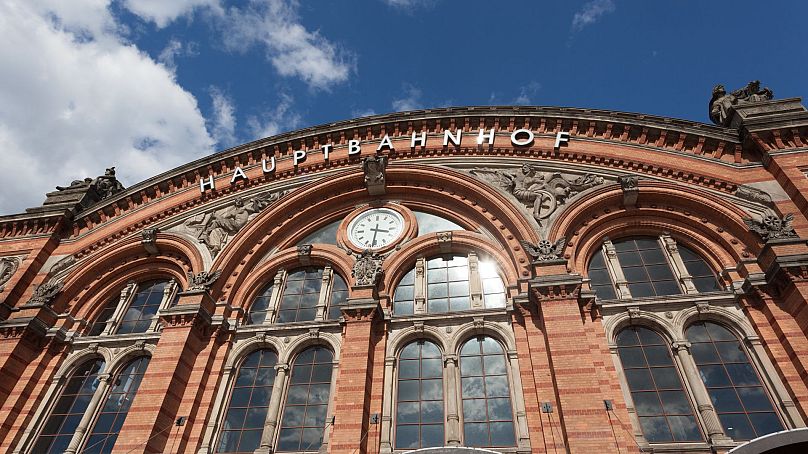Travelling by train in 2024? These are the best stations for shops, services and waiting times.
Europe’s airports are regularly ranked from best to worst to help travellers make informed choices.
With train travel surging, it’s time to look at which European railway stations offer the best travel experience.
From connections to delays, the annual European Railway Station Index analyses Europe’s 50 largest railway stations by passenger volume.
Here are the top - and bottom - railway stations for passenger convenience in Europe in 2023.
How are the train stations ranked?
The annual European Railway Station Index ranks 50 major train stations on the travel experience they provide.
Compiled by consumer advocacy group the Consumer Choice Center, it assigns points for waiting times, delays and transport connections - both locally and for onward train travel.
It also considers ticket offers, ticket booth operating times and availability of information, along with in-station services - like lounges, shops and restaurants - accessibility, smartphone apps, free wifi and the availability of ride sharing services like Bolt and Uber.
Reports from national authorities, online statistics, station maps, real-time updates and its own research on consumer expectations inform the analysis.
What’s the best train station in Europe?
After taking the crown in 2022, Zurich Hauptbahnhof in Switzerland remains number one for passenger convenience, scoring 102 points.
Its ticket office stays open from 6am to 9pm. There are special ticket offers for children, large groups, young and elderly people, and those with disabilities. The station scored especially well on waiting times, with an average of one minute, while only three per cent of trains were delayed.
With 106 shops and kiosks and 53 restaurants and takeaways to choose from, though, you’d be forgiven for missing your train.
Despite only entering the rankings this year, Vienna Hauptbahnhof in Austria has landed straight in second place, scoring highly on in-station services, onward travel and accessibility.
Berlin Hauptbahnhof in Germany secures the third spot, which it shares with another Swiss entry - Bern - followed by Utrecht Centraal in the Netherlands.
Also in the top 10 were Frankfurt Hauptbahnhof in Germany, Napoli Centrale in Italy, Amsterdam Centraal in the Netherlands, Gare de Lyon in Paris, France, Oslo Central Station in Norway and Vienna Meidling in Austria.
Choosing one of these stations for departure, transit or arrival could mean less time waiting for trains, more ticket packages to choose from, more shops and first-class lounges and better connections.
What’s the worst train station in Europe?
Among Europe’s busiest train stations, Bremen Hauptbahnhof in Germany had the lowest score for customer convenience with just 39 points.
With an average waiting time of 11 minutes and 43 per cent of trains being delayed, travellers can expect a slow journey when travelling to or from the northwest city. A lack of onward connections, no free wifi and just nine shops and 15 dining options added to its low score.
In second to last place is Munich-Pasing in Germany. The country continues to fare badly, with Berlin Zoologischer Garten, Berlin-Gesundbrunnen and Berlin Ostkreuz also in the bottom five, despite its capital’s main station making the top five.
This is mainly down to severe train delays and waiting times, but Germany’s subsidised €9 train ticket also plays a part.
Rounding out the bottom 10 were Essen Hauptbahnhof in Germany, Birmingham New Street in the UK, Châtelet-Les Halles and Haussmann Saint-Lazare in Paris, France, Helsinki Central in Finland and Firenze Santa Maria Novella in Italy.
Due to falling passenger numbers, London’s St Pancras International station was not included in the ranking.
How have Europe’s train stations changed since 2022?
Now in its fourth edition, the European Railway Station Index notes some trends and anomalies from the previous years.
In 2023, scores for all stations were lower than the previous year, marking an observable drop in quality with delays worsening as stations rebound from the pandemic, while the number of shops and restaurants have declined.
Accessibility scores improved, however, showing efforts to accommodate those who use wheelchairs and provide additional signage and directions for people with disabilities.
Ukraine’s Kyiv-Pasazhyrskyi was not included in this year’s list due to a lack of data, but the report applauds the country for managing to run 85 per cent of its trains on time while under bombardment in 2022.
Russia’s invasion of Ukraine may have impacted rail congestion across Europe since 2022, with an estimated six million Ukrainian refugees seeking shelter, it also notes.
Has Germany’s cheap train ticket scheme been a success?
Germany’s cheap train ticket scheme, introduced in 2022, led to a boom in rail travel across the country.
Of the 50 stations analysed, 21 German stations made the cut due to high passenger numbers - yet only two made the top 10. Munich has dropped to 22nd place after once coming 2nd.
Last year, the green scheme led to an 80 per cent spike in rural train travel compared to 2019, hitting smaller stations that lack the capacity to deal with large numbers. It has failed in its goal to reduce the number of cars on the roads, the report notes.
Germany has now introduced a more expensive €49 ticket to keep numbers manageable but the report says that smaller stations and local commuters have already been damaged by the €9 scheme.












